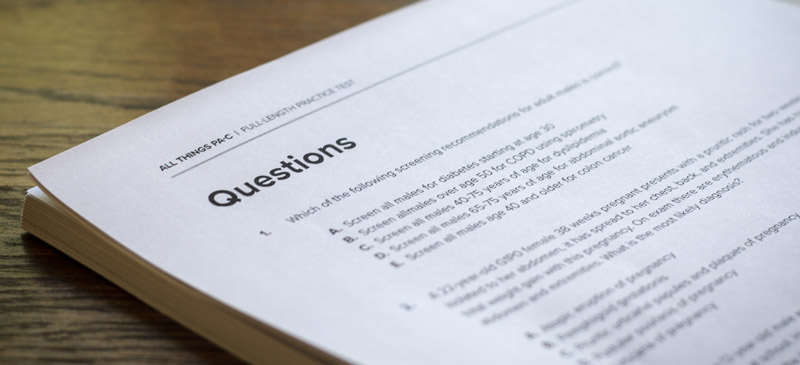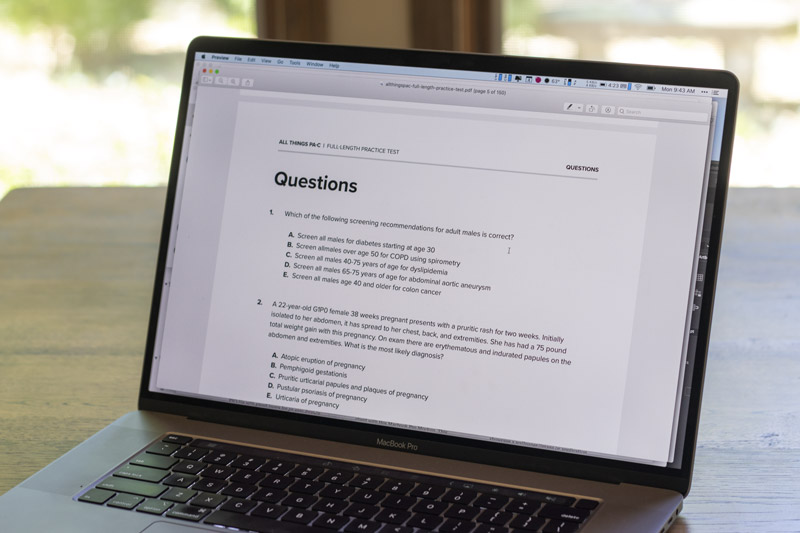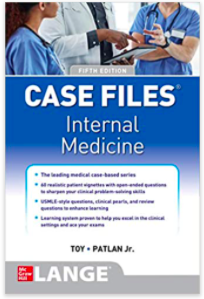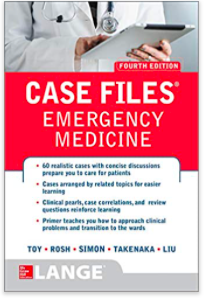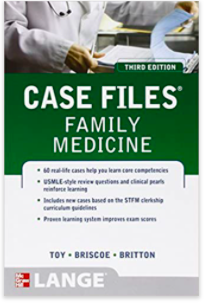Should I Consider a PA Residency?
PANCE Points + QBank
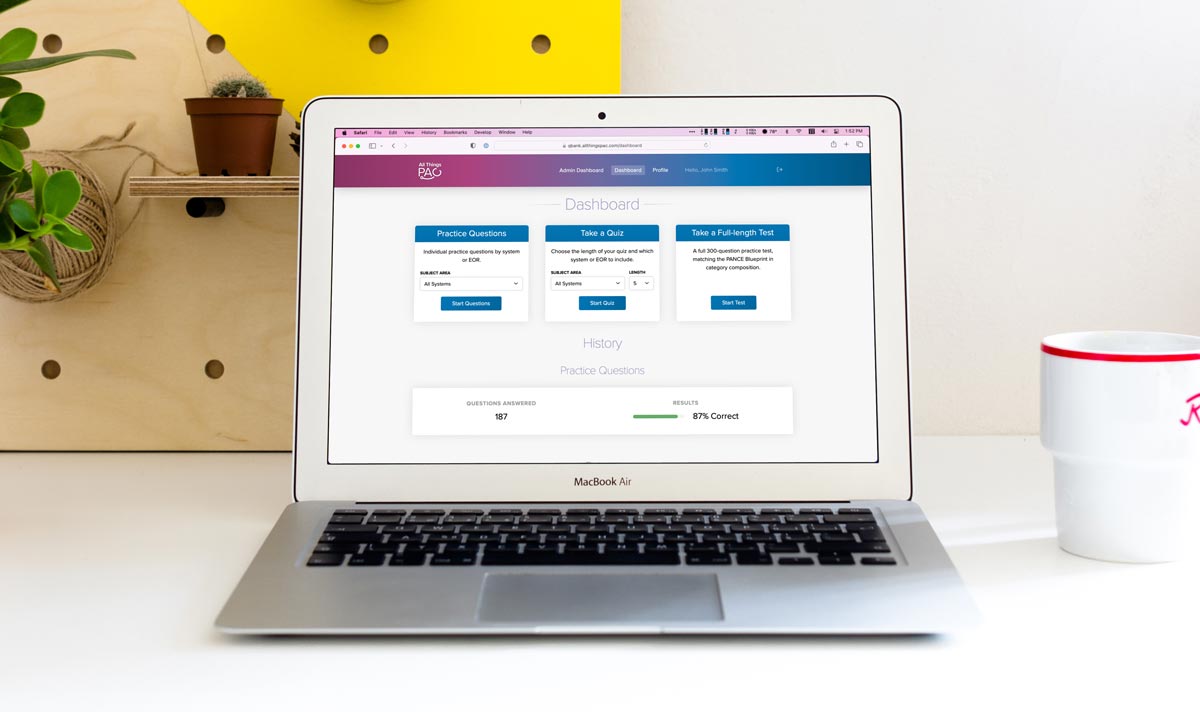
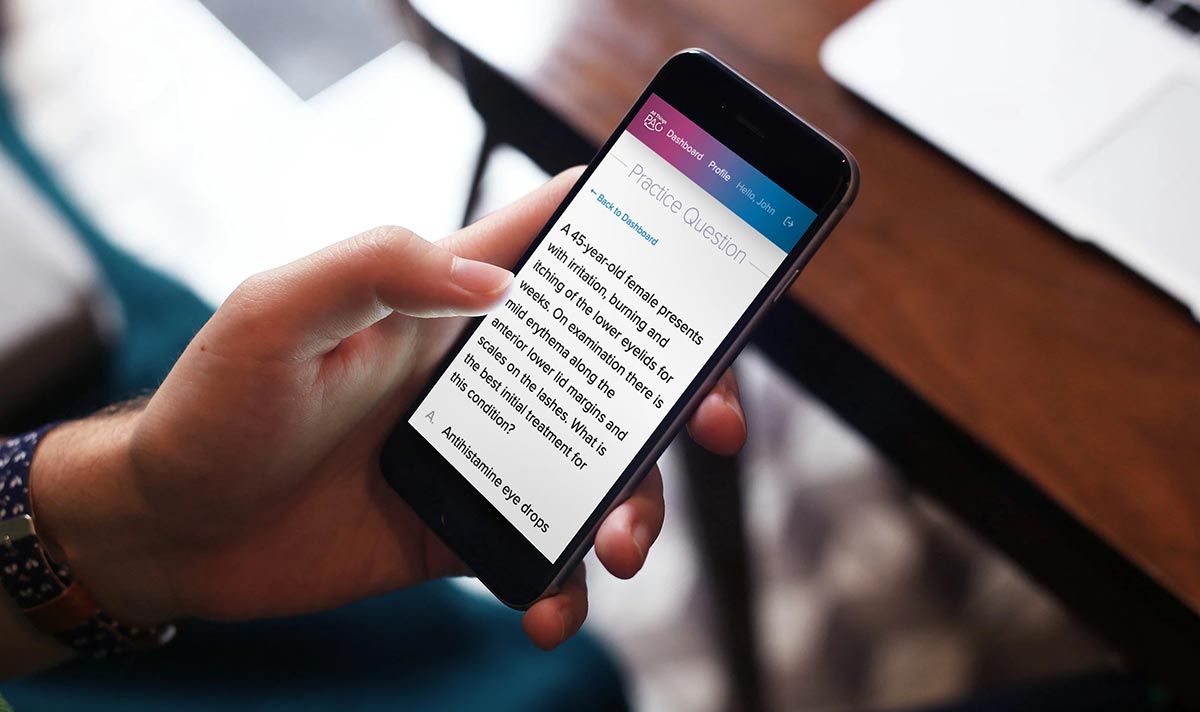
- 1,500+ questions written in the style & format of the PANCE exam
- Explanations for every answer to enhance learning
- Full-length practice tests following the PANCE blueprint
- Quizzes with choice of length & topic areas
- Individual practice questions with choice of topic areas
PA students often ask whether or not they should consider a PA residency or PA fellowship after graduating. The decision to pursue postgraduate training for PAs is like any other decision where the potential benefits should be measured against the opportunity costs. In the end, it is a personal decision individuals must make based on personal goals and preferences.
While there are many factors to consider, several advantages and disadvantages hold more weight than others. The primary benefits most often cited in favor of postgraduate education are additional focused training, a potential advantage to securing a job in a preferred specialty, and the potential for a higher income as a result of increased training and experience. The primary disadvantage of a PA fellowship or residency is loss of time and income.
Before examining each of these factors in more detail, a look at the history and current state of postgraduate education for PA students may be helpful.
A History of PA Postgraduate Training Accreditation
The field of PA postgraduate training is a little bit of the wild wild west. Unlike postgraduate training for physicians, there is currently no governing or accrediting body required to oversee PA postgraduate education. This does not mean these programs are substandard or inadequate. Most programs are associated with an academic medical center or medical residency and include intensive learning experiences through bedside teaching, lectures, mentorship, assigned reading, procedures, simulation and conferences all facilitated by well-seasoned physicians and PAs (1). But because postgraduate training is not required for PAs, most of these programs have not sought out voluntary credentialing. This allows these programs the flexibility to customize their programs and save cost.
Prior to 2000, there was no governing authority offering accreditation for postgraduate PA programs. The Accreditation Review Commission on Education for the Physician Assistant (ARC-PA), whose primary responsibility is to assess and accredit PA education programs, initiated the process to accredit postgraduate PA programs in the early 2000s. This was met with some resistance, including by AAPA. But eventually they approved a set of voluntary accreditation standards and went on to accredit a handful of programs (2).
In 2014, ARC-PA placed its postgraduate PA accreditation process in abeyance until alternative methods were developed to establish quality metrics for these programs. In 2017, interest resurfaced and by 2020 ARC-PA developed and approved new standards and a process for credentialing postgraduate PA programs. This accreditation process is still voluntary. At the time this article is published, there are currently 12 programs from nine medical centers accredited by ARC-PA. To put that in perspective, there are currently more than 140 postgraduate programs.
Accreditation is not a bad thing. It ensures an agreed-upon set of standards are met. When used appropriately it protects all parties involved including programs, students, potential employers and the public. Universities, hospitals, and many other industries require accreditation to ensure safety to the public. But it is no secret accreditation is a money-making institution. For example, a single postgraduate PA program would spend $19,500 in the first three years of the accreditation process (3). It is a fair question to ask why a program that is not required to receive accreditation, and has potentially been training PAs for years often under the umbrella of an established medical residency, would voluntarily submit for accreditation because ARC-PA has finally decided to be part of the process.
The bottom line at this point is a program’s accreditation status is not necessarily indicative of its strength or value.
Comparing the Data
Because there is no single central accreditation body, there is unfortunately a lack of comparable data to compare programs and outcomes. It is difficult to compare things like application requirements, salary and benefits, and curriculum among different programs. Additionally, there is no great research available on factors like job satisfaction, salary comparison, and employment rates between PAs who complete postgraduate training and those who do not.
The Association of Postgraduate PA Programs (APPAP) is probably the best source for PA students considering a residency or fellowship. They maintain a list of current programs and a database with the ability to filter by specialty and location, as well as compare aspects of individual programs such as start date, duration, class size, etc.
A review of available literature confirms a lack of investigation into many of the questions PA students want to know. The best study available, which reviewed the responses from 34 different PA postgraduate programs, provides some insight into these topics, but barely scratches the surface. While information is lacking, a look at what is available may help PA students identify potential pros and cons of pursuing postgraduate training.
Do PAs with postgraduate training make more money?
A common argument for postgraduate training is the potential to be hired on at a higher salary based on experience and a higher level of training. An attempt to find data supporting this has been unsuccessful. Not necessarily because it is not true, but because it simply has not been thoroughly researched.
PA fellowship and residency stipends range from $50,000-80,000 per year and average program length is 12 months (1). In comparison, the average starting salary of a recently certified PA in 2021 was $100,961 (4). A PA choosing to pursue postgraduate training accepts an opportunity cost in salary of $20,000-$50,000.
There is no definitive evidence showing PAs with postgraduate training make more than those without. A national survey analyzing this would be greatly appreciated.
Many employers maintain pay scales for physician assistants and nurse practitioners, and base starting salaries on years of experience with new graduates starting near the bottom. Many also have salary caps. It would be generous to assume employers would count educational training as years of experience. Some might. Assuming they did, it would be generous to assume an employer would start a PA with one year of experience at, say, $5,000 more than their new graduate counterpart. With this generous assumption, it would still take 2-10 years to make up for lost income from choosing a residency or fellowship. This is of course a single scenario, and there are many potential calculations. But it seems safe to conclude completing a PA residency or fellowship for the sole purpose of making more money is not a wise decision.
Are PAs with postgraduate training more likely to find a job in their desired specialty?
There are more than 150,000 PAs currently certified in the US, working in every subspecialty of medicine, and only a very small percentage of them have completed postgraduate training. In 2021, only 6.5% of recently certified PAs were in the process of or planned to complete a residency program. Only 5.2% of all PAs have completed a postgraduate residency or fellowship. Logically, the number of residency-trained PAs could not possibly fill the void of open positions in all specialties of medicine across the country, and 95 times out of 100, positions are filled by PAs without postgraduate training. There will absolutely still be job opportunities in every specialty for PAs who do not complete a postgraduate training program.
One argument worth considering is healthcare facilities who offer PA postgraduate training programs may only hire PAs who have completed a fellowship or residency, and likely hire the majority of their APPs internally out of training. In this situation, if a PA strongly desires to work at such a facility, they may have little choice but to complete a fellowship. Limiting job searches by location or specialty will always narrow employment opportunities.
Do PAs with postgraduate training find jobs faster?
90% of PAs who complete a residency are hired within two months of completing their training, presumably in the specialty they desire (1). 90% of all recently certified PAs have accepted a position after four months, a difference of only two months (4). It would be fair to say giving up 12 months in order to save two months of unemployment does not make sense.
Why Consider a Postgraduate PA Residency or Fellowship?
If not solely for the employment opportunities or salary potential, why consider a postgraduate training?
Most would say they desire to have more comprehensive training, mentorship, and supervision in the specialty they desire prior to practicing as a traditional PA. For some, this reason alone is enough to sacrifice time and income potential.
It has been my experience talking with dozens of PAs that those who complete postgraduate training highly recommend it, and those who have not say they do not feel like it held them back and do not regret their decision to immediately enter the workforce.
I have heard a few reports from PAs who regretted completing postgraduate training, usually stating it was not well organized and felt like they were utilized as cheap labor. One PA who completed a surgical residency reported her first surgical job after completing her training provided a much better on-boarding which she found more valuable than her residency.
Once again, an extensive survey of PAs who have completed postgraduate training would be extremely valuable for future PAs considering residencies or fellowships. Anyone looking for a master’s thesis, please consider this.
How Much Training is Too Much?
One of the most attractive attributes of the PA profession is program duration. Many choose PA over medical school for the chance to start practicing clinical medicine in fewer than three years. Despite this, PA students are now offered and encouraged to consider multiple paths to extend their education beyond PA school. Every year more Doctor of Medical Science and similar doctoral programs targeting PAs are opening across the country. These doctoral degrees come at the cost of years and dollars that, like postgraduate training programs, are hard to justify when looking at them from a purely financial standpoint when their goal is to become a clinician.
PAs have to ask if postgraduate training and doctoral degrees are expected to become the norm, why not spend an extra 18 months and go to medical school? PA programs already meet credit requirements that surpass most doctoral programs (the discussion on whether current PA master’s degrees should be doctoral degrees will be saved for another time). The PA program strikes a near perfect balance between effort and time required (a competitive application process and rigorous 2.5 years of education), and value (salary, job satisfaction, work/life balance, etc). As more time and effort become required, for the same value, the equation no longer makes sense.
While there is a lot of discussion about postgraduate training programs and doctoral degrees becoming “the way PAs are moving,” I suggest not letting that motivate you one way or the other. We are still years from that. We can also look to other medical professions who already ventured in that territory. Ask any of your nurse practitioner colleagues with a DNP who practice clinically if they are making significantly more money. Ask veteran pharmacists or physical therapists with master’s degrees if not having a doctoral degree has held them back after working for 20+ years. Unless you plan to teach, in most cases it will not make a difference even if PA eventually becomes a doctoral degree.
At this time I feel comfortable advising anyone considering postgraduate PA education should do so based on personal preference for advanced training, supervision and mentorship prior to entering the workforce. That is it. And if that is enough for you, I encourage and support you.
Did you complete a residency or fellowship? Please share your comments.
Sources
I’m frequently asked about the “best ____” for physician assistant students. Recently I crowdsourced this question to our instagram community and these were the most recommended bags to carry during the clinical year that are both professional and practical. Some of these are definitely investment pieces, but there are budget friendly options as well.
1. This diaper bag
Don’t knock it till you’ve seen it. Tons of people recommended a diaper bag backpack because of all the pockets and cooler storage. I’ve also noticed many people using these for everyday bags. This is one on amazon looks great and is under $25
2. The LOVEVOOK Laptop Backpack
$37 on Amazon with several colors to choose from. Several pockets for organization and an external USB port.
3. Incase backpack
My husband has carried his ICON backpack for years and I’ve always thought it looked very professional for a backpack. However, I’m loving the look of this A.R.C. Commuter pack they carry (second pic). Maybe I’ll snag one for him! Prices range $70-200+ on their site but take note they almost always run 50% off on their bags on Black Friday.
4. Bies work tote
$138 on their site, which offers a 15% off first-time purchases. Very professional looking. Large and holds it shape well. A good investment piece if you’re looking for a tote.
5. Fjallraven laptop backpack
$120 on Amazon. Multiple colors to choose from. A simple back with a laptop compartment if that’s all you’re looking for.
6. Madewell transport tote
$168 on Amazon. A simple leather tote/crossbody. You may want to consider an organizational insert but this classic bag is stylish enough for clinic and everyday use.
7. Dagne Dover tote and backpack
Pricey, anywhere from $100-300. I almost didn’t include because of the prices but several recommended these as investment bags. You decide what’s in your budget.
8. Kroser laptop backpack
$40 on Amazon. There’s a nice floral pattern as well. Several recommended this bag. It has a framed mouth for easy use as well as several inner pockets and a USB port.
9. Madewell Lorimer backpack
$138 on Amazon. Another great looking back from Madewell, if it’s in your budget. It’s only 14.5 inches tall so may not fit all laptops
10. Sherpani Soleil backpack
$120 on Amazon. Several color options. Versatile as a backpack, crossbody or tote.
This post contains affiliate links, which means if you click the link and purchase the item, I receive a small commission. All opinions are my own.
End of rotation exams and PANCE preparation requires a significant amount of self-study and independent learning. PA students have limited time during the clinical year and must optimize their study strategy. Good resources are extremely important to maximize time on task.
During the clinical year, I recommend both the NCCPA Blueprint and the PAEA Blueprint and Topic List to guide your study strategy. Focus on whatever specialty you’re in, and simultaneously review general topics and practice questions. Prioritize your general study on the categories which carry the heaviest weight on the PANCE Blueprint (nearly a quarter of the PANCE is over the cardiovascular and pulmonary system!).
I recommend a good mix of blueprint-focused outlined material as well practice test questions. For clinicals, there are a few good “rapid-fire” resources as well, which help you prepare for common questions and patients you may encounter.
While there are hundreds of guides, question banks and pocket books out there, YOU DON’T NEED EVERY RESOURCE AVAILABLE. Pick a few that utilize a variety of learning methods such as outline format, case studies, rapid-fire, etc. And make sure you have plenty of practice questions as they are of the most important study methods for learning and retention!
Here are 5 great resources for the clinical year and PANCE prep:
1. The All Things PA-C PANCE practice exam
Of course I recommend our exam! We created it after realizing there weren’t enough quality practice exams or practice questions that won’t break the bank. Studies show practicing exam-style questions are one of the best study methods for passing board exams. Doing at least one full-length exam is recommended before you sit for the PANCE and you won’t find a more affordable option than this. Questions are modeled using NCCPAs style guide and most closely resemble what you’ll see on the PANCE.
2. Smarty PANCE

It’s no secret I’m a fan of Smarty PANCE. A couple of reasons I love it so much is it follows the NCCPA and PAEA blueprints, and is heavily focused on practice questions. The content is concise yet covers all the most pertinent information on each topic. You can use it for a quick review or more in-depth studying if desired. It’s also one of the best bargains out there as far as what you get for what you pay. I have a blog post with a full-review of Smarty PANCE that includes a discount code at the end you can use for 10% off.
3. A Comprehensive Review for the Certification and Recertification Examinations for Physician Assistants

This is the only resource developed and endorsed by the American Academy of PAs (AAPA) and the Physician Assistant Education Association (PAEA). This is the resource I personally used the most for studying. I utilized it for the PANCE and my first PANRE. Following the NCCPA blueprint, each chapter focuses on a body system and outlines in a concise, easy to read format everything you need to know. Each section has a few PANCE-style practice questions to assess your knowledge.
4. The Case File Collection
The Case Files Collection is a great resource for clinical rotations and PANCE review. It was one of my favorite resources to use while studying for the PANCE and PANRE. There is a book for almost every specialty, each containing dozens of practical clinical cases covering the most relevant topics. Each case includes a complete discussion, clinical pearls and references, definitions of key terms, and PANCE-style review questions with detailed explanations of the correct answers. If you’re lucky, your program may have access to these if they subscribe to Access Medicine. If not, it would be expensive to purchase them all. I recommend internal medicine, family medicine, and emergency medicine as they cover a large portion of the NCCPA blueprint.
5. Pocket Passed
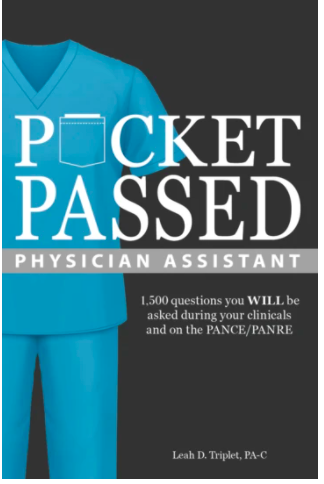
I recently had the chance to review Pocket Passed, and was very impressed. Small enough to fit in your pocket or bag, you can pull it out during down time between patients or keep it close anytime you have a few minutes to spare. It includes 1,500 rapid-fire questions you are likely to be asked on rotations, over content that is covered on the PANCE. Having one good rapid-fire resource in your collection is a good idea, and this is one I’m really digging right now.
Remember, there are many resources out there. You don’t need to break the bank, but consider this an investment as you prepare to take some of the biggest exams of your academic career. Also, make sure to check with your program and see what resources they have available to borrow or utilize. Access Medicine and Ovid/Lipincot, for example, are electronic databases many PA programs subscribe to and have some include some of the resources above.
I started All Things PA-C in 2018 after noticing a lack of quality and affordable resources for PA students. One of the few exceptions to this was Smarty PANCE. As a result, I have enthusiastically recommended it for PA students as a core study guide.
I’m not the only one. Smarty PANCE is repeatedly the most recommended resource from PA students on my platform.
The program is versatile and serves PA students in both the didactic and clinical year as well as those preparing to take the PANCE. It somehow manages to meet the needs of everyone at once.
For those not familiar with Smarty PANCE, it’s a PANCE and PANRE review course designed specifically with the needs of PA students in mind. This isn’t a program designed for medical students and repackaged for PAs. It was created by a PA versed in the unique needs of PA students. It’s a helpful resource for PA students any time during their education, particularly through the latter didactic and entire clinical year.
The Features
The best features of Smarty PANCE are
- It follows NCCPA and PAEA Blueprints
- It is heavily focused on practice questions.
You all know how I feel about practice questions and their value. Quality questions are extremely important for PANCE preparation and the foundation of my resources as well.
Depending on where you are in school, you can choose to focus on EOR exams, the PAEA End of Curriculum Exam, or the PANCE/PANRE.
The Layout
The program format is divided so you can choose a “course” in any of the 14 PANCE blueprint medical content categories (system, dermatologic system, system, EENT, GI/nutrition, genitourinary, hematologic, infectious disease, musculoskeletal, neurologic, psychiatry/behavioral science, pulmonary, renal, and reproductive systems).
Within each course, you can chose to study by one of several options:
- Read through a clinical summary of every disease and disorder for that system
- Practice flashcards
- Review case presentations (each disease state is presented as a patient presentation followed by key pearls, diagnosis, and treatment)
- Study interactive practice questions with answers and explanation
- Take a comprehensive system exam
You basically get to choose the method of study that works best for you or best fits your schedule, or do them all as a comprehensive review. In addition, there are audio and visual lectures for each system. It literally covers every method of study.
For those in early didactic coursework, reading through disease states as you learn them and reviewing flashcards may be the most meaningful. Those in late didactic courses may prefer case presentations and practice questions. For those in their clinical year, exams are also categorized by EOR (end of rotation) with both EOR study guides and EOR practice exams. There is also a PAEA End of Curriculum exam review.
Why Chose Smarty PANCE?
Study resources are outrageously expensive. If your program doesn’t cover Rosh, Kaplan, or any other big name review course, you will spend hundreds, sometimes thousands of dollars for board review prep. Smarty PANCE includes everything for an unbeatable price and is specifically designed with PAs in mind. The creator and I share the vision of offering quality and affordable resources for PA students, which is why I recommend and support his product.
I recommend the one-year all access pass for $75, but there are several purchasing options available.
You can use this link and the code ALLTHINGSPAC for 10% off your purchase.
This post contains affiliate links, which means if you click the link and purchase the item, I receive a small commission. All opinions are my own. Thank you for trusting me to share quality products I use and love.
I’m frequently asked about gift ideas for PA students or new grads, which is why I love putting together a holiday gift guide. The 2019 gift guide was a huge hit, so we’re back for 2020! I really like to think through both fun and practical ideas for PA students. So, here you go!
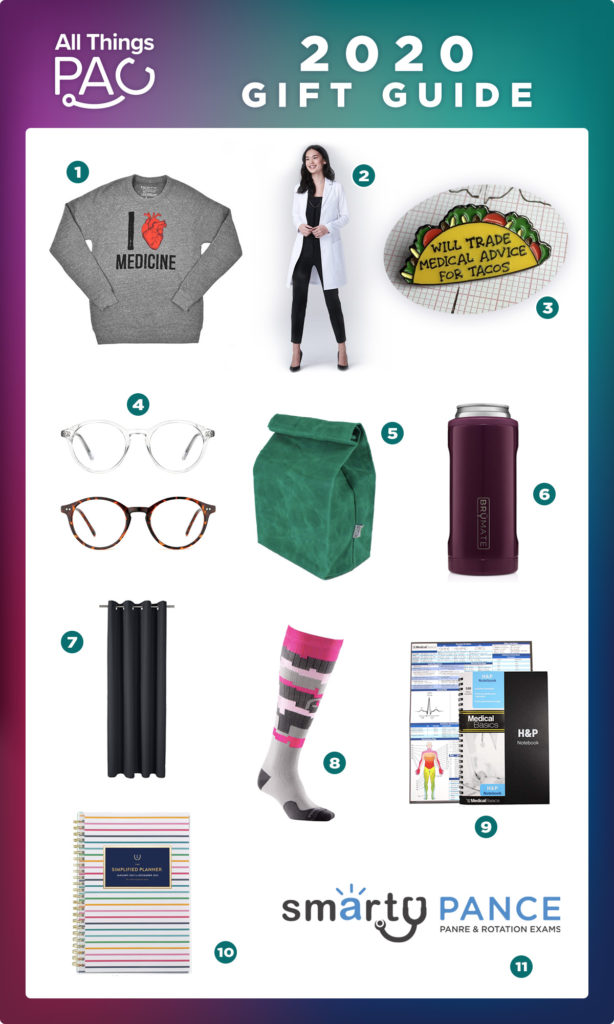
1) Medthusiast T or Sweatshirt
I love Medthusiast for so many reasons. The company was founded by a PA and has fun, witty medical T’s and sweatshirts for all healthcare professions. I’m not lying when I say my fleece “I Heart Medicine” sweatshirt is the most comfortable thing I own! Plenty of witty medical puns to choose from, including some specific for PAs!
2) Medelita lab coat
Another PA founded company, Medilita makes stylish and quality labs coats, scrubs, and medical clothing. I own many lab coats and my Medelita Vandi fit is my absolute favorite. It’s the classic black dress of lab coats. The embroidery is beautiful. Purchase one for your favorite PA students with their name and “PA-C” credential; it’s the perfect gift to motivate them through the rest of school. Medelita is currently running a 30% off Black Friday sale!
3) Rad Girl Creations pin
Need a budget friendly gift idea for your favorite PA? Rad girl creations has witty pins to add some fun flare to your lab coat, as well as other fun gifts like decals, mugs, socks, badge wheels and more. Most gifts are under $15
4) Blue light filtering glasses
Whether you’re a student studying all hours of the night, or a practicing PA, we all spend too many hours behind screens. Especially over the last year with the added strain of Zoom calls and virtual meetings. Protect your eyes with these blue light blocking specs which are practical and stylish! I have this pair and keep one at home, and one in my work bag.
5) Canvas lunch bag
We all know packing a lunch is healthier and cheaper than eating out day after day. These canvas lunch bags are environmentally friendly and pack well in your work bag or backpack. Perfect for students and clinicians!
6) BruMate slim can
Not just for seltzers and beers, these BruMate insulated cans will keep any 12 oz slim can cold for hours. Use it for energy drinks before those early morning shifts and classes, and for your favorite cold beverages on the weekends.
7) Blackout curtains
This may be an unusual gift to ask for, but trust me you’ll be thanking me after your first stretch of night shifts. Schedules for PA students and PAs doing shift work can be chaotic, and creating an optimal sleep environment is key to restoration and performing your best.
8) Compression socks
Working those long shifts on your feet during clinclas isn’t easy, and having a good pair of compression socks is a must. These Pro Compression socks are stylish and provide great support. There’s a pattern or bright color to match every personality.
9) H&P Notebook
Back by popular demand, this H&P notebook is perfect for students on rotations and PAs that round on many patients. It has 100 H&P templates to write notes now, and staff with your preceptor or document electronically later. They’re perfect for keeping patient logs while on rotations, too.
10) Simplified planner
This is the only planner I’ve ever managed to keep and utilize throughout an entire year. The concept of Emily Ley’s Simplified Planner is exactly that, to simplify your life. The calendar has a simple layout with a schedule and to-do list for each day. Not too much, not too little. It’s perfect for students; mark your exams and important dates, plus what you wish to accomplish each day.
11) Smarty PANCE subscription
Besides the All Things PA-C practice exam, Smarty PANCE is the number one resource I endorse and recommend for PA students. Not just for PANCE prep, the resources in Smarty PANCE will help you summarize didactic content and review key pearls during the clinical year. The program contains courses, quizzes, practice questions, EOR exams, flashcards, and video lessons among other things, and follows the PANCE blueprint. The price is unbeatable compared to other PANCE prep resources, plus you can get an additional 10% off using code ALLTHINGSPAC. This is a perfect thing to ask for if someone is offering!
This post contains affiliate links, which means if you click the link and purchase the item, I may receive a small commission. All opinions are my own.
The American Medical Association posted an article in October of this year insulting not only PAs, but NPs, pharmacists, psychologists, and optometrists. It was yet another display of their insecurity and ego under the disguise of patient safety.
I won’t link to the blog, but you can Google and find it if you’d like. I don’t want to draw any more page views to their site, further feeding their ego. Before it was taken down, their Facebook post had 3.6K impressions, 2.6K comments, and 682 shares. To put that in perspective, the majority of their other posts receive less than 20 likes and comments per post. Why does this matter? Impressions tell the social media algorithms that people enjoy their content and subsequently share it with more people. The overwhelming majority of comments on this particular post are from PAs and NPs. By flooding their post, there’s a good chance we’re actually causing their message to spread further. We don’t want to feed the monster.
Why do I not care what they think about PAs? Because it doesn’t matter. What matters is our patients and giving them quality care.
The whole premise of AMA’s campaign is that every patient deserves “physician-led care.” On the surface, that’s not surprising or entirely extreme. But it is arrogant. It’s arrogant because what patients fundamentally deserve is access to quality care. And anyone arguing access to quality care is currently sufficient, is being willfully ignorant.
So let’s all agree that what patients ACTUALLY deserve is access to quality care. Now back to AMA’s statement. Their tagline is, “Patients deserve care led by physicians – the most highly-educated, trained and skilled health care professionals. Through research, advocacy and education, the AMA vigorously defends the practice of medicine against scope of practice expansion that threatens patient safety.”
What’s implied here is any care provided by a non-physician is not safe. That’s a bold statement. One that, if said, should be supported with evidence.
To back this up, AMA goes on to site findings from their own recent survey as evidence of this safety concern. The results they highlight from this patient survey are as follows:
- 91% said a physician’s years of education and training are vital to optimal patient care – especially in the event of a complication or medical emergency.
- 86% said patients with one or more chronic diseases benefit when a physician leads the primary health care team.
- 84% said they prefer a physician to have primary responsibility for the diagnosis and management of their health care.
- 75% prefer to be treated by a physician.
- 75% said they prefer to be treated by a physician – even if it takes longer to get an appointment and costs more.
Forgive me for stating the obvious, but these are patient PREFERENCES. This is NOT evidence that other providers provide unsafe care. I’m a PA and would answer yes to several of these questions!
I could not find the survey AMA used. So I can’t say this with certainty, but I would guess it had leading questions, and was given to an older patient population. We know from our own studies that older patients tend to be more comfortable with traditional care provided by physicians. It’s most likely what they’ve known their entire life, so it makes sense that would be their preference. It doesn’t mean care from other providers is unsafe, nor does it mean it is unwelcome. We also know that when you ask younger patients, the responses are different.
I’m not going to link a bunch of studies showing how advanced practice providers provide quality care. I’m not going to attack the studies cited by those who oppose APPs saying they don’t. Why? Because each side will find holes in their opponents’ studies, even though we were all trained no research is perfect. Physicians will provide anecdotal stories of patients who were harmed by NPs and PAs. APPs will refute this and provide their own stories of colleagues who identified a diagnosis missed by physicians.
None of this will move the needle. Which brings me back to why I don’t care what the AMA thinks about PAs. Because it doesn’t matter. What matters is taking care of my patients.
The bus is gone and it’s not going back. Health care systems are hiring PAs and NPs at an exponential rate, holding them to the same quality and safety outcomes physicians are held to. The local health care system in my community now has more APPs than physicians. Patients are getting access to care that wasn’t there before.
Those who don’t want to get on the bus, who prefer to stay back complaining and arguing they don’t think it’s fair, can stay back. The rest of us are moving on. The physicians who appreciate our role, the health care systems that recognize our value, and the payers who know we save money, are not going to bow down anymore just because AMA doesn’t like it. Do they really have the audacity to think that ALL of us are wrong?
I say that not to be antagonistic, but because it’s reality. And trying to argue with people who refuse to move forward will put you on a fast track to burnout. It will get you nowhere.
So what is it I implore you to do?
Be a great PA. Take excellent care of your patients. Do your job and do it well. Go the extra mile. Work as a team-member, respecting our physician colleagues for the leading roles they provide on those teams.
We aren’t at a crossroads. This isn’t up for debate. PAs and NPs are here to stay. If the AMA wants to be left behind comforted by their echo chamber, that’s their prerogative. But we don’t have to waste our time arguing with them. Our patients need us too much.
The PA program I work for recently finished up interviews for 2020. We typically do an MMI, but were forced to use a more traditional interview style via Zoom due to COVID-19.
Most PA programs use a 2:1 to 3:1 ratio of interviewees to seats. Meaning, if they accept 50 students, they will interview 100-150 applicants. Many programs receive hundreds of applications, all of which have to meet minimum qualifications to even apply.
A few candidates always stand out before the interview process. They have 4.0 GPAs, thousands of HCE/PCE hours, and stellar recommendations. A handful of applicants on the other end of the spectrum barely pass the threshold for meeting minimum requirements. Most applicants fall somewhere in the middle. On paper, they are very equally qualified.
The interview is where applicants have an opportunity to stand out. It’s where programs decide who is a good fit for their culture. I don’t know if it was the virtual setup, or the change from MMI to standard format, but this year more than ever it was challenging for applicants to stand out.
There are more resources for PA applicants than ever before. This is a good thing. When I was applying to PA school there was NOTHING out there. Now you have everything from books on the topic, virtual shadowing opportunities, Pre-PA clubs, and personalized pre-PA coaching or application reviews.
One problem this has created, however, is that applicants are frequently giving the same canned answers for many of the standard interview questions. Specifically questions like “Why PA over physician?” and “Why do you want to be a PA?”
I quickly started to identify buzz words for lack of a better term on these topics.
Let me give you a few examples. “Lateral mobility.” “Work-life balance.”
Don’t hear me wrong, the ability to switch specialties and a better work-life balance are some of my favorite things about our profession. But as an applicant, you need to be able to tell me why this is important to YOU. This can be particularly tricky, because it can come out sounding like you’re choosing the “easy” road. One colleague of mine often states he feels like PA applicants don’t seem to understand that just because they’re becoming a PA and not a physician doesn’t mean their job isn’t going to be stressful.
Another popular topic this year for PA programs is diversity and inclusion. Anyone with a pulse can say they think diversity in healthcare is important. Anyone should be able to recognize the lack of diversity in healthcare. But again, 90% of applicants had the same generic and very basic answers to these questions.
The answers provided were not wrong. The problem is, they weren’t PERSONAL. Remember, programs are interviewing dozens of candidates. In many cases over 100. I need to remember something about you when the interview is over. The best way for me to remember you is to tell your story. When I ask a question, I’m not looking for a canned answer. I’m looking for YOUR answer.
An interview is nothing more than a marketing campaign for yourself. One marketing expert I follow named Donald Miller discusses how neuroscientists claim we spend more than 30% of our time daydreaming. Basically, we can’t focus. However, something very interesting happens when you read a book or watch a movie – you don’t daydream. The reason is when you’re engaged in a story, it does the daydreaming for you. He teaches businesses how to use storytelling to market their products. I believe this concept can be applied to selling yourself in an interview, too.
If you want to capture the attention of someone or want them to remember you, you have to tell a story. Your story. I promise you when I’m on the twentieth PA interview candidate telling me about how PAs have “lateral mobility,” it’s all I can do to keep from daydreaming. But when I hear a candidate tell me about a personal experience they had with a patient that made them want to become a PA, I’m engaged.
You still have to answer the questions though, right? That’s ok. You can do both. When practicing interview questions, think of your answer in two parts. First, the most direct answer to the question. Second, why this is the correct answer for you personally.
Let me give you a few examples:
“Why are you considering PA over physician?”
If I were answering this question, I would say:
“I considered several pathways including physician. Something I kept coming back to is PAs have more flexibility with changing career paths. One thing in particular that solidified this for me is I have a friend who finished her medical residency and was extremely unhappy with her specialty. I watched her work tirelessly through medical school and residency only to find out she is very unhappy with her decision, and now she’s stuck. She encouraged me to think about this, and the more I did, the more I realized having flexibility to practice in different specialties was more important to me than having the benefits that come with being a physician.”
I made the question personal and I told a story.
Here’s an applicant who was asked this same question a few years ago, and I still remember his response:
“My family always struggled with being in debt and never having enough money. I want to do things differently. I’m ready to start working as soon as possible. If becoming a PA allows me to do what I want to do, which is practice medicine, in a shorter amount of time and with a third of the student loan debt, that’s the clear choice for me. A PA income is more than enough for me to live comfortably and I don’t need the status that comes with being a physician. I just want to practice medicine.”
This person answered the question without making it sound like becoming a PA was the “easy” thing to do, and he made it very personal, all in under 20 seconds.
Let’s use diversity as an example. A lot of applicants struggle with this because they may not have a lot of life experience and really fumbled with how to answer questions that called for giving personal examples. If that’s you, it’s ok. You can still own your lack of experience and show us how it will make you a better PA.
Example:
“I actually don’t have any personal experiences where I’ve seen discrimination happen. I think this may be because I grew up in a town and went to schools with very little diversity. I grew up in a small town where everyone in my school was white. My college was mostly white. What I’ve learned from watching events unfold this year and from listening to others is, just because I haven’t witnessed it doesn’t mean it isn’t happening. I’m learning I need to be proactive in learning about discrimination in health care and learning about the experiences of others.”
This response owns the fact they don’t have an experience to share, tells a little bit of a personal story, and discusses how it will make them a better PA.
Let me say here, this isn’t intended to be a canned answer either. My hope is everyone truly understands the importance of diversity and inclusion among healthcare providers and we all recognize the disparities that exist for minorities when it comes to healthcare. Don’t give an answer that isn’t sincere.
If you’ve worked in healthcare as a scribe, medical assistant, etc, and you can’t come up with ANY example about how a minority or someone of low socioeconomic status was treated differently or struggled to navigate the healthcare system, you probably aren’t paying enough attention. That’s ok, it’s never too late to start.
If I were interviewing for PA school, I would write down all of the standard questions you know are asked. “Why PA?”, “Why our program?” It’s very likely you’ll have a question about diversity.
Make two columns. In one, write down your short answer. In the second, write down a personal story or why this answer is true for you. Then practice merging the two columns together to come up with a prepared response.
2020 has been a crazy year, and the PA interview process was not spared from this. I hope these tips help you express your true self during your interview.
On the first day of orientation for PA school, our program director stood in front of the class and presented a PowerPoint presentation on what to expect and how to succeed during PA school. About halfway through the presentation, there was a slide titled “Don’ts.” Underneath was a long list that included buy a house, get a puppy, get married, or have a baby.
I understand their intentions. I really believe my faculty simply wanted us to be successful. But looking back with a little life under my belt, including some years where a pretty strong headway was made on equality for women, it really doesn’t seem right to lecture to a group of young adults in their mid 20’s about when it’s appropriate to start a family.
This issue isn’t new. Medical students and residents likely feel the weight of this issue even more, given the length of their training. And as Dr. Laura Forese, VP and COO of New York Presbyterian hospital, said: “Expecting women to delay pregnancy until after medical school and residency — which can take more than eight years — isn’t reasonable or moral, given the increased risk of infertility and pregnancy complications among older women.”
During our first breakout session we introduced ourselves to classmates at our table. One sitting across from me told me his wife had a baby yesterday, and here he was at orientation. In his defense, he hadn’t seen the list of “don’ts” yet.
Two male classmates and three female classmates would have a baby before my cohort graduated, and two of my female classmates were pregnant when we graduated. Two others got married the summer between our didactic and clinical year. I’m not sure if anyone got a puppy, but I’m sure someone probably did.
And guess what? We all made it. We all graduated and have had successful careers as PAs.
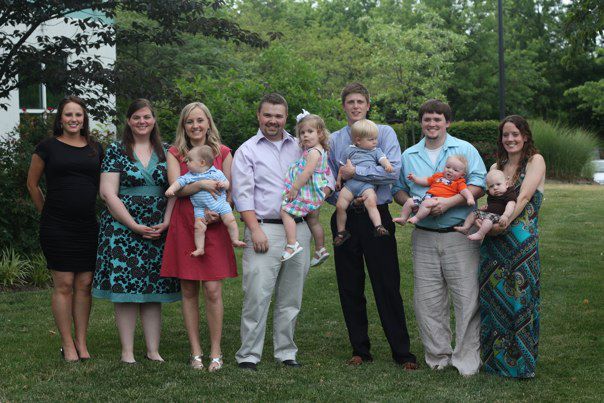
PA graduates from my class with babies or expecting, at our graduation banquet
I got married at 23, and knew I wanted a big family. I also very much wanted to be a PA. My husband and I discussed a timeline, but by the time I finished the first year of PA school, my longing to be a mother was almost unbearable. My parents had always told me that if you wait for the perfect time to have kids, you’ll never have them. And while I think it’s totally fine to have a loose plan, I completely agree with them.
We didn’t have a ton of money, but people with far less money still have kids. Yes I was in school, but how would that be much different than if I was working? And the big question that always lingered in my mind… What if getting pregnant took months or even years? I had friends who were struggling with fertility, and I knew plans don’t always work out the way you want.
So we decided to “not try not to have a baby.” 3 weeks later, I was pregnant. This was right before my clinical year started. I honestly don’t even remember the conversation I had with my faculty. Maybe it was through email? I’m not sure. The fact that I don’t remember it tells you how uneventful it really was. I don’t know what kind of discussions happened behind the scenes, but they were nothing but supportive and understanding to my face.
I was very blessed to have a healthy and uneventful pregnancy. I had women’s health during the month of December when I was about 32 weeks pregnant, and my preceptor thought I was a patient on my first day. I had never seen a live birth or really even been around a newborn for very long. I remember on my first or second day, we rushed over to the hospital for a birth. I was hobbling along when my preceptor looked back and said “Can you move any faster?” He was only half joking, and we made it to the room right as the mom was beginning to push.
She had chosen to have an unmedicated birth so it was a little intense. I remember the nurses helping me gown up because I couldn’t reach my feet to put my boot covers on very well. The baby came out fast and furious. I’m not super emotional in front of people, but the whole event of seeing my first birth (which was unmediated and quick), and knowing I as only weeks away from having my baby, hit me really hard. Before I knew it tears were welling up in my eyes. My preceptor looked at me and said “I bet you hope your baby comes that fast don’t you!”
Deliveries can be kind of busy, and I felt in the way (this would get better as the rotation went on). But I saw the dad trying to film himself cutting the umbilical cord, so I asked if he wanted me to take the camera and film it for him. He was thankful for the offer. So I actually filmed the first few minutes of the newborn’s life, dad cutting the cord, and took a few pictures of the family for them. I will remember that as one of the highlights of PA school.
All that to say I was able to remain on clinicals right up until I went into labor. I finished women’s health and started my pediatric rotation. I went home after one shift during the second week, and my water broke that night. So I literally worked up until the day I had him.
Our school had a medical leave policy that included up to three months off if needed. I decided to take 8 weeks off, but when the time came to return my pediatric site wasn’t able to accommodate me. So I ended up taking 10 total weeks off. I went back and added 2 weeks of pediatrics at the end of my program to complete that rotation. My class graduated in May, and I finished in August. Other than a few months of being jealous they were all finished and passing boards, it really didn’t affect me much.
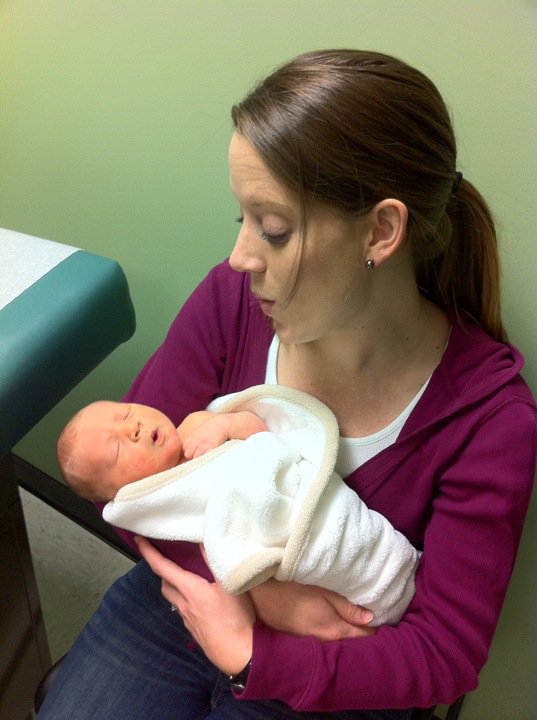
First pediatric visit at 2 days old 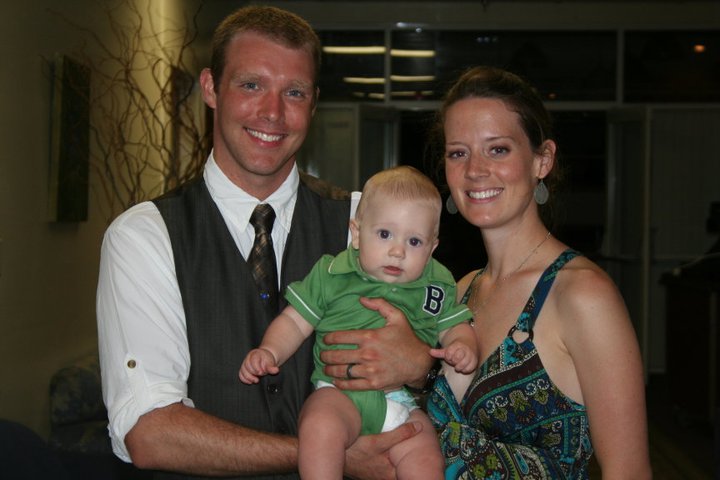
Family of three at my PA graduation banquet
My husband and I decided to move back home, around three hours from where I attended PA school. I arranged to have an away rotation near our new home for my last clinical. I did end up having to go back for two weeks and stay with a friend to finish up my pediatric rotation at the very end.
I was also able to breastfeed and pump through the reminder of school. This was something that always made me a little anxious because with each new rotation I had to let my preceptors know I was pumping. But they were all nothing but extremely supportive. I would usually use an empty exam room, or in one case the hospital I was in actually had a nice lactation room.
My son was 6 months old when I finished PA school, and I wouldn’t trade how I did any of it. I ended up interviewing for a job around the time I was finishing school. I took a month off to study for and pass the PANCE, then started my new job. I would find out I was actually pregnant again (my first two are 16 months apart), so I ended up having to start a new job and tell them I was pregnant shortly after. So I have experience with that too, but the bottom line is everything is figure-out-able. It really just is.
So if you’re considering having a baby during PA school, I want to let you know it is possible. It’s also completely fine if you choose to wait. My advice is, do what is best for you and your family. Fear of what others think (i.e. your faculty) should not be a factor in the equation. It’s not their lane, it’s yours.
I would be familiar with the medical leave policy for both your program and your school. Know your rights under Title IX when it comes to protection around pregnancy and parenting. You should also consider the possibility that your pregnancy may be complicated and require more time off than you plan for. All of these things are possibilities, but I simply don’t believe in making decisions out of fear.
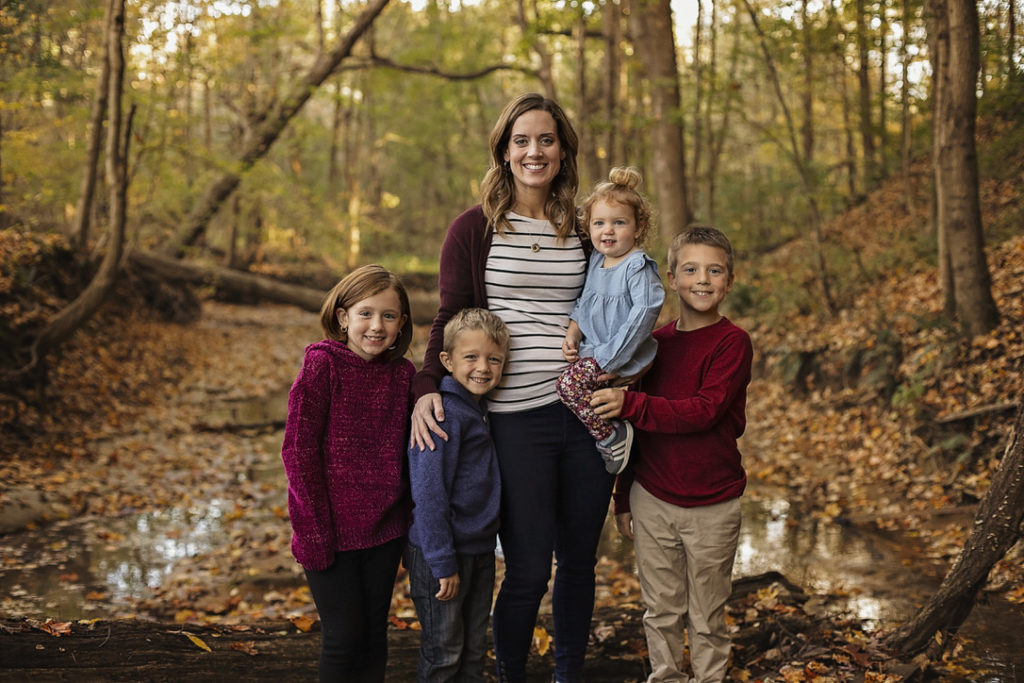
2020 with all those babies I wanted
I hope this is helpful to some who may be in the same shoes I was in. Feel free to email me with any questions, I’m happy to help if I can.
The last post on my blog is about how and why I started All Things PA-C. If you missed it, check it out here. Here in part 2, I’ll discuss how I grew a large Instagram following and the tools I used to create and grow my business.
To make things simple, I’ll break this down into a few subcategories: getting started, techy tools, social media, and educational resources.
Getting Started
One of the first things you should do when starting a business, is come up with a name. You want to think this through. Is the domain (website name) available? Is the handle available on all social media platforms? Is it easy to remember and spell? Go ahead and snag the social media handles and a Gmail email account, because those are pretty easy. Then you’ll need to purchase the domain name through a domain registrar. We purchase and manage all our domains with Hover.
The next step I recommend is register your business with the state. There are several types of business entities and a tax attorney or other resources may help you figure out what’s best for you, but I chose an LLC. If you’re wanting to make money, don’t skip this step. It sets you up as a legit business and shows this isn’t just a hobby. If you’re selling a product, you’ll likely have to register with your state’s department of revenue to pay taxes on your sales. If you’re not selling a product, this step can wait and honestly when you get to that point, I highly recommend you consult with an accountant.
Another step you don’t want to skip is setting up a bank account specific for your business. Even if you’re not making a lot of money, or any at all when you first start. I recommend the first dollar you earn, open a separate account. You don’t want to mix your personal finances with your business. This may not seem like a big deal at first, but if your goal is to make money in your business, you’ll wish you had done this. At some point you’ll have to make purchases and investments and if your accounts aren’t separated you’ll never know where you stand on income and expenses.
Don’t let this stuff overwhelm you. Taking one small step builds confidence and creates momentum. Settle on a name and start an Instagram account. Then purchase a domain name. That’s a great place to start.
The Techy Stuff
Building a Website
I’ve mentioned before, my husband is a web developer and graphic designer. So admittedly I was completely hands-off on this step. However, I can relay some advice.
First of all, DO have a website. You could build a million followers on Instagram and wake up one day and your account is shut down without notice. Or hacked. Or the algorithm changes and your followers stop seeing anything you post. This happens everyday to people. Instagram, Facebook and any other social media platform are borrowed spaces, and you don’t own them. They are great resources to extend your reach and serve your audience, but you do not control what happens on them. You do control your own website. Always have your own website if you own a business.
The easiest, simplest thing to do is use an all-in-one service like Squarespce or Wix. You don’t have to be tech savvy to use these. You essentially chose a template and fill it in. If you’re doing something like a blog, either of these would work great. My website is run on WordPress, which is widely used free software for running a website, but it requires installation on a web hosting account and a bit more work and ongoing maintenance. This site runs on Dreamhost, but there are tons of great web hosting options.
The benefit of Wix or Squarespace is they are easy. The benefit of WordPress or other web software you install yourself is the ability to customize and have full control over how your website looks and works. For example, we’re currently building the All Things PA-C questions bank and I can basically make it look and work however I want, ensuring it’s user friendly and meets the objectives of what I want it to be. And when I say “I,” I mean my husband who knows how to code. So I appreciate this isn’t a free resource everyone has. The good news is, WordPress has become so widely used, there are tons of resources to help you learn how to use it, as well as themes and plugins that are relatively easy to install.
Posting Tools
I’ll talk more about growing an Instagram following in a minute. But I am confident one of the driving forces behind my successful growth on Instagram was consistent posting. In Part 1 I talked about how challenging this was, but I posted twice a day to Instagram for an entire year. Not a single digital marketing expert doesn’t agree posting regularly and frquently is one of the key strategies to growing a following.
I could not have done this without a social media scheduling program. I work full time and have 4 kids, and we’re an active family. I am busy. But like I said before, All Things PA-C was build on hard work between 8 and 10 PM every night. While my friends were Netflix binging after the kids went to bed, I was up writing practice questions.
Once a week, usually on Sunday, I’d spend about about 30 minutes getting my posts ready. You can prep your images and write the captions and hashtags all in advance. The act of posting only took about 60 seconds out of my day. I used PLANN, and really liked the software. But I have trouble recommending them because I’ve run into several issues and they do not have great response times or customer service. This blog does a good job recommending some different options. If you’re planning on primarily focusing on social media, I highly recommend a paid scheduling app.
Design Tools
I draft all of my practice questions in a Google Doc initially, but all of my Instagram posts are created in Canva. Canva is a graphic design platform where you can create all sorts of images. They have great templates for Instagram posts and stories, Facebook, and really just about anything. There is a paid version of Canva but anything I’ve ever needed is available on the free option.
Starting An Email List
This goes a little beyond the scope of this post, but I don’t want to leave this out. If you plan on growing a business, start collecting email addresses ASAP. Every marketing expert will tell you the number one revenue stream for businesses is not through Facebook or Instagram, it’s through email. When you’re ready to sell or offer something in one, two, or even three years from now, you’ll wish you had started an email list on day 1. I incentivize people to give me their email address by offering a free practice quiz. I then try to send regular emails with more personal or valuable content than what I share on Instagram. It almost feels like my email subscribers are my core group I to interact with. I use a service called Mailchimp to collect email addresses and send email campaigns.
Social Media
There’s a of curiosity about how my following grew so rapidly when it’s becoming more challenging to grow on both Instagram and Facebook. Now, I understand I’m not Taylor Swift, but in just over a year All Things PA-C has grown to almost 24,000 followers. There were no gimmicks involved. I wouldn’t know how to use any if I wanted to. I absolutely attribute this to
- Posting frequently and consistently, and
- Posting QUALITY content.
You will notice my posts serve a few purposes. The questions are to provide value. I’m not afraid to share some of my product for free. Some would disagree with sharing so much of what you’re selling for free, but I don’t. I want you to trust me and know that if what I’m offering for free is this good, what I’m charging for is going to be worth it. The second objective to my posts are to create community, usually by asking questions that bring PAs and PA students together in a fruitful discussion or allow them to share experiences and resources with each other. And lastly, I post valuable information about our profession in general. Every post has a purpose and meets one of these objectives.
You don’t see a lot of my face on my page. I go in spurts where I’m on stories, but to be honest I don’t want to HAVE to be the face of my business. Some people really enjoy that. I just figured out early that showing bikini pictures with a clever caption about being a PA wasn’t going to sell my products or build a community (Ok truth – I never actually posted a bikini picture, so who knows, maybe it would have worked). If you’re wanting to be an “influencer” and use yourself as the face of the brand, there is nothing wrong with that. Just make sure what you post is providing VALUE to your followers.
Try an experiment. Scroll through Instagram and take note of what posts catch your eye and why. What feeds do you love, and why do you love their images or captions? Because there are a million photos of cute PAs in Figs with a clever caption. So how are you going to stand out if that’s your strategy?
Education
This post is already too long, and I still feel like I have so much to share. Again, this really is a passion of mine and I would love to see some of you who are interested in starting a business succeed as well!
What I’ll list to end this article is my favorite resources for navigating the world of online marketing and entrepreneurship. I tell people I got an MBA through podcasts and books when I started All Things PA-C. These resources have helped me more than anything and they cover every topic you could imagine.
Podcast
- The Goaldigger Podcast with Jenna Kutcher (probably my fav)
- Online Marketing Made Easy with Amy Porterfield
- Storybrand by Donald Miller. He has a podcast with the same name which is also great but this book is GOLD if you’re trying to figure out where to start with your branding
- Smart Passive Income with Pat Flynn
If you hung with me, hopefully that means you have a real interest in this stuff. Please reach out if you have any questions!
This isn’t your typical topic for the physician assistant profession, but it’s one I get a lot of questions about. So today I’m telling you about my experience building a side hustle as a PA. In part 1, I’m discussing what lead me to this journey and how I got started. In part 2, I’ll give you some practical tips and resources if it’s something you’re considering as well.
I love my job as a PA. I love the profession. But I’ve never felt comfortable with 100% of my income coming from an employer. Even though our profession has continued to be very stable, COVID in particular has revealed we are not immune to layoffs, pay cuts, and furloughs.
I’ve talked about following the Dave Ramsey plan before. Dave talks about how most wealthy people have multiple streams of income. I don’t dream of becoming a billionaire, but my financial peace includes knowing if I were to lose my job tomorrow, my eggs aren’t all in one basket. While many PAs including myself work PRN for extra income, it still isn’t something that I have complete control over.
Two years ago I went on maternity leave for 12 weeks. I was looking for a creative outlet to have fun during my leave, because I’m really bad at sitting still. I also wanted something new and refreshing to keep me from burning out in my clinical job. If my new project was something I could make money off of, great. But my initial goal was truly to find a creative hobby.
I’m a PA, but also a registered dietitian and have a strong interest in health and wellness. I also love writing, being a mom, gardening, and trying to live sustainably. So I started a wellness and nutrition blog, writing about health topics, recipes, sharing my experiences as a mom with four kids, and my amateur attempt at homesteading in our farmhouse on 4 acres. I still post to that page and it’s still very much my fun, creative outlet.
There was a learning curve to starting a blog. My husband is a web developer, so when I told him my idea, he built a site on WordPress for me. But I learned quickly there is much more involved in running a successful blog than getting a website up and running. I dove into learning all I could. I was fascinated by the world of online education, social media, entrepreneurship and digital marketing. I tell people I got an online MBA through podcasts that year. I spent hours learning about influencers, marketing strategies, and email lists.
I figured out early on I wasn’t interested in using these strategies for my blog. The online nutrition space is a vast world of fad diets and pseudoscience. Some of it’s ok. A lot is bad. Really bad. In order to gain followers or sell a product, you have to make big promises. I knew telling people “Exercise to feel good, try to eat right but don’t stress too much about it, and learn to focus on your health and how you feel instead of your weight” probably wasn’t going to gain a lot of followers. I decided it would simply be my hobby, which it still is.
I then started thinking of other ways I could apply my newfound interest in online entrepreneurship to another project. When I went back to work at my family medicine job after maternity leave, I was still trying to come up with an idea for an online business. Then one day, it hit me – I think there’s room for PA education in the online space.
I’ve precepted PA students for years. I really enjoy educating and helping students navigate PA school, and mentoring them in the early stages of their careers. I’m not so far removed from PA school that I don’t remember the struggles. I particularly remember trying to get my hands on as many practice questions as I could, especially towards the end of the program when I was taking EORs and preparing for the PANCE exam. I also remember being frustrated at the price of these products.
Right after graduating, I went to a board review course which cost hundreds of dollars in course fees and travel expenses. I sat for 8 hours a day for 3 days while people read PowerPoints. If you’re considering a board review course, let me tell you the ONLY thing of value I received were copies of the PowerPoint outlines (which cost extra to have printed) and three 60-question practice exams with answers and explanations. Other review courses and question banks, even online products, cost hundreds as well.
I thought, “That’s it, I’m going to make practice questions for PA students.”
I was extremely late to the Instagram party. I’m on the tail end of Gen X right where it crosses over Millennials. In fact, I think I get the choice based on which one I resonate most with. My @villagefarmlife Instagram page (for my personal blog) pretty much includes my family and friends. So believe me when I say no one was more surprised than me when I started the @allthings_pa_c Instagram account and grew it to more than 20,000 followers in one year.
Eventually I would want to monetize All Things PA-C. What that looked like wasn’t clear in the beginning, nor was it a priority. I knew before I could even think about making money, I would need to build a community, and serve them well. I also knew this wasn’t going to be easy. Online businesses and influencers may make it look easy, and there are probably some that just smile for the camera, activate the swipe up feature and make thousands of dollars every day.
But the vast majority who are financially successful work very hard behind the scenes. There are accounts with 10,000 followers that make millions, and accounts with 100,000 followers that can’t make a dime. There’s so much more to it than people realize.
I decided I would post practice questions, and other interesting facts and resources for pre-PAs, PA students, and practicing PAs. Education experts and psyshometricians (scientist who study test-taking) say it can take 45 minutes to draft a good multiple choice question. As I do when I become interested in something, I dove head first into the science of writing test questions. I also researched almost all other PANCE and PA resources on the market to see how good other products were and where there were deficiencies.
I went to an item-writing workshop and learned so much about the process of test creation and how questions for the PANCE are written. While it doesn’t take me 45 minutes a question, drafting them was a time-consuming task. I won’t go into the details here, but my questions are quality. I use multiple up-to-date resources and all topics come from the NCCPA PANCE content Blueprint. Questions are written in the same format and follow the style guide of the PANCE. Not every source out there, even the more expensive ones, can say that.
I set a goal to post one practice question and one interest post every day for one year. I can’t tell you how many times over the next 365 days I hated being someone who follows through with personal goals. But I did it. 740 posts, 365 of those being practice questions, from March 2019 to March 2020. And again, these weren’t just cute flashy photos, they were questions and posts that took time to create and edit. This was to serve my followers. When I eventually did have a product to sell, I wanted people to know they could trust me.
About half way through the year I decided my first product would be a PANCE practice exam. The questions were so popular and I knew there was a need for an affordable resource like this. So that’s what I did.
I had a little help editing and polishing the questions from another PA and had a small beta group of Instagram followers who took the test for free in return for edits and feedback. My husband helped me with the tech stuff – setting up the landing page, delivery automation, credit card processing, etc.
I really didn’t know what to expect, but the product has gone over very well. I’ve received some great feedback and testimonials from people who used it as study resource during their clinical year or before taking the PANCE.
I’m sure if I calculate the time I put into all of this and figure out dollar per hour, I’d probably cry. My husband has helped me a lot through this. Without his skills I would’ve had to pay to outsource a lot of “techy” things, or spend many hours trying to learn it. The only disagreement we had was over the price of the practice exam. He recommended that I charge more based on the time and energy to develop it, plus the market costs of similar products. But I wouldn’t budge. One of my core values from the beginning was to make AFFORDABLE resources, and I wanted to keep the price of this first product low.
The best part about an online product is, once up and running, there’s potential for passive income (the ability to make money even when you’re not working). I knew that if the product was good, I could price it low enough for students to afford it and still make money.
I’m certainly not quitting my job and moving to the beach anytime soon, but I’ve made enough money and had enough fun to realize I want to keep going. My current project is working on a large question bank. Soon PA students won’t have to spend $500+ for access to practice questions! I’ve also learned a large number of my followers are pre-PA students, so I’m looking at ways to serve them as well. I still work full time and love my job, but it’s recently become very demanding and I need this creative outlet now more than ever.
@theandreabenedict is a PA and founder of Medthusiast. She talks a lot on her account about being an entrepreneur and running a side business as a PA. I’ve heard her talk about how she can work all day but still come home and work on her business because it’s her passion.
I resonate with that a lot. All Things PA-C was built working from my home office every night after my kids went to bed. Even though the work is hard, it energizes me. Not only do I love the actual work – researching and writing questions, providing resources and communicating with all of you – but like Andrea, I really enjoy the business aspect of it. It’s why on days like today, even after long hours with my “day job,” I can stay up finishing a blog post and writing a few practice questions.
I hope this was helpful to some of you thinking about starting your own side gig. Whether it’s making a physical product, digital product, or some other business endeavor, I want to be your cheerleader. It’s a lot of hard work, but PAs are some of the hardest workers and smartest people I know.
In part 2, I’ll share some practical tips and tricks as well as resources I used to get All Things PA-C off the ground and grow a large social media following. I hope you come back!

